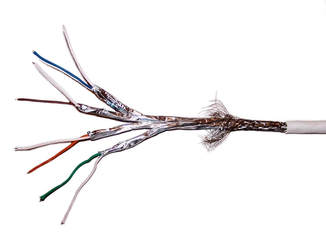|
In this post we’re talking about Cats! Not the fluffy feline kind but the cable kind. You may have heard of Ethernet cable being referred to as Cat5 or Cat6 or even Cat7 and wondered what it all means. In this post I’ll explain what they are and the differences between them.
Why Cat? Cat is short for Category, it’s as simple as that. The first category these days is 5, there were earlier Categories but that was quite a while ago and they aren’t really relevant these days. In fact just to add to the confusion Cat5 isn’t really used these days, the lowest form of cabling is really Cat5e, the ‘e’ stands for 'enhanced'. How is a Ethernet cable made up? All the cables are slightly different but fundamentally the same (between Cat5-7). They are all a cable made up of 8 smaller cables encased in an outer sheath, the 8 cables are then broken down into pairs which are twisted together; this is why you’ll sometimes see the letters 'TP' after a cable's name, it means 'twisted pair'. The pairs are colour coded, blue,orange,green,brown. Each pair has one cable a solid colour and the other white with coloured stripes, for example blue and white with blue stripes (see picture at top of post). Why are there different categories? There are three enemies of communication cables they are: attenuation, crosstalk and interference. Attenuation is the loss of signal out of the cable, crosstalk is signal escaping from one part of the cable and getting into another, interference is something out of the cable getting in and interfering with the signal. Each new category of cable is trying to reduce these three issues. The categories of cable Cat5e Cat5e is one of the most widely used cables types and has been used for nearly 20 years. If you have an Ethernet cable for your router or your Playstation etc. the chances are it is Cat5e. It’s a great cable and for almost all requirements it is sufficiently fast; supporting speeds of up to 1Gs (in theory) The speed will depend on the length of the cable and whether it is shielded. Shielded Cat5e is the same as normal Cat5e but it has a foil casing which sits inside the plastic sheathing, it has a better performance because the foil reduces loss of signal through attenuation . Attenuation is electricity escaping and reducing the signal strength, the less attenuation the better the signal, the faster the speed. You may also see the letters LS0H after some cables, this stands for Low smoke zero halogen, and refers to what happens to them when they catch fire. It is a safety feature designed for internal installations, you can also get fire resistant cabling. Additionally there is external Cat5e which has a thicker, more durable outer sheathing to protect it from the elements. There is even armored Cat5e which has a thick wired shielding to protect the cable from damage. Lastly there are patch cable Cat5e, this type of cable is designed for use in patch panels which is where all the cables come together before plugging into a switch. I’ll explain more about these in a later post. Patch Cat5e uses multiple strands of copper rather than one solid cable to offer more flexibility, making it more suited to patch panels. Cat6 Cat6 is essentially the same as Cat5e in it’s make up but is faster, and some times it has a plastic separator in the cable which splits apart the four pairs. Cat6 is faster because of tighter coils on each cable pair; this also increase the thickness of the cable. Cat6 can produce speeds of up to 10Gs (10x faster than Cat5e). All the variations that you can get on Cat5e you can also get on Cat6 (and 7) but additionally there is another cable called Cat6a. This has even tighter coils and a thicker outer sheath. This cable can also produce speeds of up to 10Gs but it can maintain that for a much longer distance than normal Cat6 (37m vs 100m). Cat7 Cat7 is the daddy of Ethernet cabling (although not officially recognised). Each twisted pair is foil covered and the four pairs together are then encased in a braided metal sheath (inside the outer plastic sheath). This greatly reduces attenuation and crosstalk and means the cable can produce great speeds at a long distance. Cat7 is an excellent cable but it might seem to be overkill for your home. You could be right, but on the plus side you would certainly be future proofing your network. So that's that! I hope you have found this a useful explanation of the different types of Ethernet cables, if you have any questions please comment below. If you are interested in having Ethernet installed in your home then please give us a call for a free quotation 01628 299272. If you like this post please share and like. You can find us on Facebook too.
2 Comments
15/11/2018 05:01:17 am
Informative blog, just a quick question tho, do you still think that Ethernet cables would be still available in the near future when wireless internet is more preferred?
Reply
8/5/2023 10:12:57 pm
Upgrade your network infrastructure with Cat6 cables in bulk! Get faster speeds, greater bandwidth, and reliable connectivity. Buy now and save big!
Reply
Leave a Reply. |
Huw Jones
Owner of Home Network Solutions Berkshire Categories
All
Archives
May 2024

|

 RSS Feed
RSS Feed
